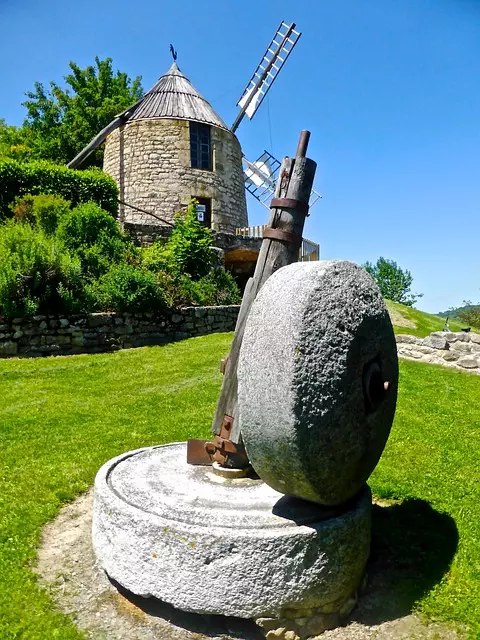In Toledo, Ohio, the integration of advanced pavement milling and grinding techniques plays a vital role in maintaining and sustaining its infrastructure. These processes not only extend the lifespan of roadways but also facilitate the eco-friendly reuse of materials, contributing to both cost savings and environmental sustainability. Specialized equipment and operator expertise are employed to address the challenges posed by Toledo's harsh weather conditions, particularly during the extreme winters and humid summers. The city's commitment to professional development for operators ensures high standards of workmanship, while strategic planning and real-time monitoring systems ensure operations are carried out efficiently, even under adverse climatic conditions. The recent sustainable infrastructure projects in Toledo, such as the major road rehabilitation, highlight the city's dedication to incorporating innovative practices that set a benchmark for urban road maintenance and offer a model for other cities to follow.
The intersection of infrastructure maintenance and technological advancement has never been more critical than in the realm of pavement milling and grinding. As Toledo, Ohio continues to invest in the longevity and safety of its roadways, the efficiency and effectiveness of these operations are paramount. This article delves into the intricacies of maximizing productivity in pavement milling and grinding, spotlighting innovative technologies, strategic planning, and material handling practices that contribute to optimal outcomes. From the bustling streets of Toledo to the broader application of these methods, we explore how advancements in this field are transforming infrastructure management. Join us as we navigate the key elements ensuring that pavement milling and grinding projects meet high standards of quality and timeliness, ultimately paving the way for safer and more sustainable road networks.
- Maximizing Efficiency in Pavement Milling and Grinding Operations
- The Role of Advanced Technology in Enhancing Toledo, Ohio's Pavement Milling and Grinding Projects
- Strategic Planning for Effective Pavement Milling and Grinding Scheduling
- Material Handling Best Practices for Optimal Pavement Milling and Grinding Outcomes
- The Impact of Weather Conditions on Pavement Milling and Grinding Operations in Toledo, Ohio
- Training and Certification for Operators: Elevating Skills in Pavement Milling and Grinding
- Case Study: Successful Pavement Milling and Grinding Projects in the Toledo, Ohio Area
Maximizing Efficiency in Pavement Milling and Grinding Operations

Efficiency in pavement milling and grinding operations is a critical factor in maintaining and upgrading infrastructure. Advanced techniques and machinery in pavement milling and grinding, such as those utilized by experienced professionals in Toledo, Ohio, have significantly improved the process’s speed and precision. These advancements allow for the removal of damaged asphalt or concrete to be executed with greater accuracy and less material waste, ensuring a more durable surface once reinstalled. The integration of technology, including GPS-guided milling machines, enables contractors to navigate complex job sites with ease, reducing the time required to complete each project. Additionally, the use of high-performance grinding tools not only enhances the efficiency of the operation but also extends the lifespan of the pavement, as the precise removal of surface layers can address issues such as surface wear and water infiltration without the need for complete pavement replacement. The expertise of teams in Toledo, Ohio, exemplifies the commitment to excellence within the pavement milling and grinding industry, setting a benchmark for other regions to follow.
The success of pavement milling and grinding operations hinges on a combination of skilled labor, state-of-the-art equipment, and strategic planning. In Toledo, Ohio, the fusion of these elements results in seamless execution of tasks from site preparation to the final grading and compaction of the newly milled surface. The use of real-time data and monitoring systems ensures that each phase of the project is completed within the optimal parameters, minimizing downtime and maximizing productivity. This approach not only accelerates project timelines but also improves the quality of the finished product, which is essential for maintaining roadways and infrastructure systems. The dedication to continuous improvement in pavement milling and grinding processes in Toledo reflects a broader trend towards increased efficiency and sustainability within the construction industry.
The Role of Advanced Technology in Enhancing Toledo, Ohio's Pavement Milling and Grinding Projects

In Toledo, Ohio, the advancement of pavement milling and grinding technology has significantly elevated the efficiency and quality of infrastructure maintenance. The integration of cutting-edge machinery and software solutions in the pavement milling and grinding process has led to improvements in surface preparation for roadways. These enhancements enable contractors to work more precisely, minimizing disruptions and accelerating project completion times. The sophisticated technology utilized in Toledo’s projects includes laser guidance systems that ensure a high degree of accuracy and consistency, as well as milling machines with optimized cutting heads that can adapt to various pavement conditions. This technological prowess not only streamlines the process but also extends the lifespan of the city’s road network by providing a more refined and durable surface finish. The use of advanced sensors and monitoring equipment further contributes to the safety and sustainability of these projects, with real-time data facilitating better decision-making and resource allocation.
The positive impact of this technological evolution is evident in Toledo’s ongoing pavement milling and grinding initiatives. These projects are not only about repairing and maintaining the city’s road infrastructure but also about incorporating smart technologies that can adapt to future needs and challenges. The seamless integration of these innovations into the operational workflow has set a new benchmark for pavement maintenance in Toledo, Ohio. By leveraging the latest advancements, the city is poised to deliver high-quality road surfaces that stand up to the wear and tear of everyday use, ensuring smoother and safer travel for all its residents. The continuous investment in pavement milling and grinding technology underscores Toledo’s commitment to infrastructure excellence, making it a model for other cities to follow in adopting smart solutions for urban development and maintenance.
Strategic Planning for Effective Pavement Milling and Grinding Scheduling

In the realm of infrastructure maintenance, strategic planning plays a pivotal role in executing effective pavement milling and grinding operations. To optimize productivity in this context, it’s crucial to consider the intricacies of scheduling and resource allocation. Pavement milling and grinding processes involve the removal of asphalt or concrete from a surface to repair or resurface roads. The success of these operations hinges on precise planning, taking into account weather conditions, traffic patterns, and material availability. In Toledo, Ohio, for instance, where the demand for pavement milling and grinding services is consistent due to its strategic location and heavy road usage, planners must integrate advanced scheduling systems that can adapt to changing circumstances. These systems help in forecasting project timelines, managing equipment fleets, and coordinating with local agencies to ensure minimal disruption to traffic flow. By leveraging technology and local expertise, pavement milling and grinding operations in Toledo can be conducted with maximum efficiency, safety, and environmental consideration, ultimately contributing to the longevity and quality of the city’s road network. The integration of real-time data and predictive analytics allows for dynamic scheduling that can respond to urgent needs while maintaining a long-term view on infrastructure health. This proactive approach not only enhances productivity but also ensures that Toledo’s streets remain in optimal condition, supporting the mobility and safety of its residents and commuters.
Material Handling Best Practices for Optimal Pavement Milling and Grinding Outcomes

In the realm of infrastructure maintenance, pavement milling and grinding play a critical role in extending the lifespan of roadways. This process involves removing the surface layer of asphalt or concrete to repair or resurface roads. To achieve optimal outcomes in pavement milling and grinding, adherence to material handling best practices is paramount. One such practice is the careful selection and transportation of equipment to the site, which should be done with precision to minimize any potential for damage or wear. In Toledo, Ohio, where environmental conditions can vary, it’s crucial to ensure that the machinery used for pavement milling and grinding is capable of performing efficiently under diverse weather scenarios. This includes selecting appropriate blades and bits designed to handle the specific composition of the pavement, as well as equipment that can adapt to different temperature ranges and moisture levels, which are common in the Toledo region. Proper material handling during pavement milling and grinding not only enhances the quality of the work but also contributes to cost savings by reducing downtime due to malfunctions or repairs. Additionally, the efficient handling of the removed material, often referred to as ‘millings,’ can be repurposed for other projects, such as new pavement layers, which further supports sustainable construction practices and minimizes waste.
The success of pavement milling and grinding operations is also contingent upon the skilled operators who execute these tasks with precision and care. They must be trained in the latest techniques and safety protocols to ensure that the work is completed effectively and safely. In Toledo, Ohio, the best practices for material handling extend beyond the machinery to include comprehensive operator training programs that cover everything from machine operation to the proper disposal or recycling of millings. These programs not only enhance worker safety but also improve the overall quality of the pavement milling and grinding outcomes. By investing in such training, local agencies and contractors can ensure that their projects adhere to high standards, resulting in smoother, more durable road surfaces that withstand the test of time and heavy traffic in Toledo’s bustling urban environment.
The Impact of Weather Conditions on Pavement Milling and Grinding Operations in Toledo, Ohio

The intricacies of pavement milling and grinding operations in Toledo, Ohio, are significantly influenced by the region’s weather conditions. The unpredictable climate, characterized by harsh winters and humid summers, presents unique challenges for the precision and efficiency required in these processes. During the winter months, frozen ground and snowfall can delay or even halt pavement milling operations due to safety concerns and the need for specialized machinery adaptations. Conversely, the hot and humid summer days present their own set of difficulties; the high temperatures can affect the material properties of the asphalt, necessitating careful temperature checks before milling begins to ensure optimal performance and minimal damage to the pavement structure.
In Toledo, Ohio, the strategic planning and execution of pavement milling and grinding operations must account for these weather-related variables. The use of advanced technology and real-time monitoring systems allows contractors to adjust their operations accordingly, ensuring that work is completed effectively despite adverse weather conditions. For instance, precise temperature sensors can determine the ideal time to mill, avoiding overheating or cracking of the asphalt. Additionally, scheduling these operations during more favorable weather windows, typically in the late spring and early fall when the weather is most stable, is a common practice among local contractors. This approach not only enhances productivity but also contributes to the longevity and quality of the pavement milling and grinding work performed throughout Toledo’s infrastructure network.
Training and Certification for Operators: Elevating Skills in Pavement Milling and Grinding

In the realm of infrastructure maintenance, pavement milling and grinding plays a pivotal role in road rehabilitation and maintenance. As such, the proficiency of operators in this specialized field is paramount to achieving optimal results. Training and certification for operators in pavement milling and grinding are not just ancillary steps; they are critical components that elevate the skill set required to effectively manage these operations. In Toledo, Ohio, as in many other locations, these professionals undergo rigorous training programs designed to familiarize them with the intricacies of machine operation, safety protocols, and material handling. These courses often include hands-on experience, enabling operators to refine their skills through practical application. The certification that follows validates their expertise, ensuring a higher standard of workmanship across pavement milling and grinding projects. This commitment to professional development not only enhances the quality of infrastructure repair but also contributes to the longevity and safety of roads in Toledo and beyond.
The emphasis on continuous training and certification for operators in pavement milling and grinding is a testament to the industry’s dedication to excellence and compliance with stringent operational standards. In Toledo, Ohio, this commitment translates into smoother, safer, and more efficiently maintained roadways. Certified operators are well-versed in the latest techniques and technologies, which not only improve the efficiency of pavement milling and grinding operations but also extend the life of the roads they work on. This expertise is invaluable, as it ensures that each project is carried out with precision and care, ultimately leading to a more robust and durable infrastructure system.
Case Study: Successful Pavement Milling and Grinding Projects in the Toledo, Ohio Area

In the Toledo, Ohio area, pavement milling and grinding projects have been pivotal in maintaining and upgrading the region’s infrastructure. These projects not only extend the lifespan of existing roads but also facilitate the efficient reuse of pavement material. The successful implementation of pavement milling and grinding in Toledo exemplifies a cost-effective approach to road maintenance, where the ground-up pavement is recycled into new materials, thereby reducing environmental impact and project costs. The city’s initiatives have showcased a robust framework for sustainable infrastructure management. For instance, a recent project involved the comprehensive milling and resurfacing of a major arterial road, which significantly improved traffic flow and safety. This operation was conducted with advanced machinery capable of precise milling operations, ensuring minimal disruption to the local community while maximizing the efficiency of material reclamation and reuse. The success of these projects hinges on meticulous planning, expert execution, and the use of state-of-the-art technology in pavement milling and grinding processes. The Toledo area’s commitment to such endeavors underscores the importance of investing in long-term infrastructure maintenance, setting a benchmark for other regions to follow.


